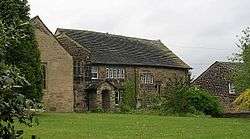Calverley Old Hall
Calverley Old Hall is a medieval manor house with Grade I listed building status situated at Calverley, West Yorkshire, England.
- For the house with a similar name in Cheshire, see Calveley Hall

Architectural features
Significant portions of the house have unusually escaped alteration and modernisation in later centuries. The oldest section of the property is the solar, believed to be of 14th-century origin. The great hall, which has an interesting 6-bay hammerbeam roof, and the chapel have been dated to 1485–1495. Later additions include an accommodation wing added in the early 16th century by Sir William Calverley to house his very large family.
Calverley family
The Calverley family settled in Calverley in ancient times and remained for several hundred years. In the mid-17th century Walter Calverley (b. 1629) married Francis Thompson, heiress of the Thompson estate at Esholt. In 1709 their son Walter built a new mansion house at Esholt Hall, and the family left Calverley. After his death in 1749 the family sold the Esholt estate, and in 1754 they sold the Calverley properties to the Thornhills. Thereafter the hall was subdivided into cottages.
The hall was witness to dreadful violence in April 1605, when Walter Calverley murdered two of his sons, William and Walter, after drinking heavily [1]. He was tried in York for murder, but refused to plead and was therefore pressed to death. Because of his refusal, his property could not be seized by the state, and passed to his surviving baby son.[2] The murder inspired the Jacobean play A Yorkshire Tragedy, the authorship of which was attributed to William Shakespeare in the first printed edition (1608) but which is now thought to have been written by Thomas Middleton.
Modern times
In more recent times the hall has enjoyed humbler tenants. The chapel was let out as a wheelwright's shop. In 1981, however, Landmark Trust bought and restored the hall, which they let out as holiday accommodation.
References
- Levin, Carole (2016). A Biographical Encyclopedia of Early Modern Englishwomen (1st ed.). London: Routledge. p. 137. ISBN 9781315440729.
- The History of Calverley
External links
| Wikimedia Commons has media related to Calverley Old Hall. |